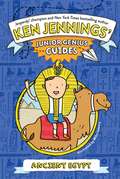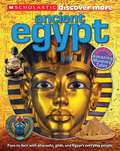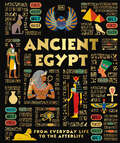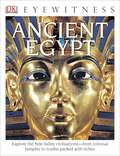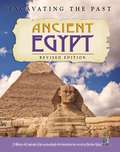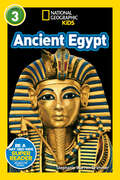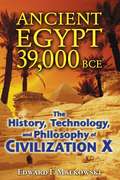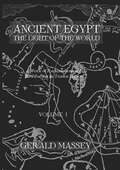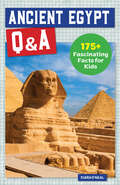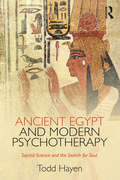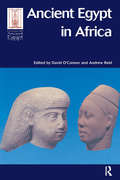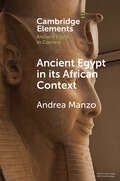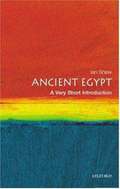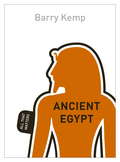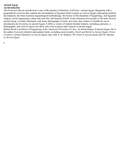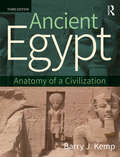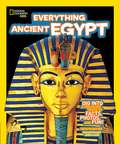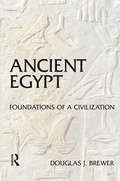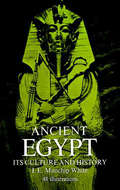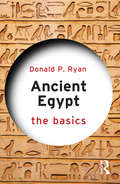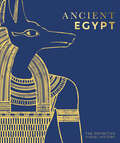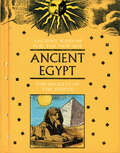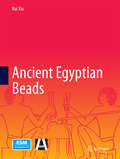- Table View
- List View
Ancient Egypt
by Ken Jennings Mike LoweryTravel back in time to the age of the pyramids with this interactive trivia book from Jeopardy! winner and New York Times bestselling author Ken Jennings.With this book about ancient Egypt, you'll become an expert and wow your friends and teachers with awesome ancient facts: Did you know that some Egyptians used to shave their eyebrows whenever a cat died? Or that some people worshiped a god of lettuce? With great illustrations, cool trivia, and fun quizzes to test your knowledge, this guide will have you on your way to whiz-kid status in no time.
Ancient Egypt
by Penelope ArlonA new generation of reference books for kids used to surfing and swiping! This book is packed with exclusive photos so that kids can see ancient Egypt like never before! The images are accompanied by time lines, step-by-steps, and cross-section graphics for original and startling insights into pharaohs, mummy making, and pyramids. Most of all, the book encourages children to think for themselves: Was King Tut murdered, or did he die of natural causes? Can you decode hieroglyphics and read the Book of the Dead?
Ancient Egypt
by Salima IkramThis book provides an introduction to one of the greatest civilization of all time - ancient Egypt. Beginning with a geographical overview that explains the development of Egyptian belief systems as well as its subsequent political development, it examines methodology, the history of the discipline of Egyptology, religion, social organization, urban and rural life, and death. It also includes a section on how people of all ranks lived. Lavishly illustrated, with many unusual photographs of rarely seen sites that are seldom illustrated, this volume is suitable for use in introductory-level courses on ancient Egypt. It offers a variety of student-friendly features, including a glossary, a bibliography, and a list of sources for those who wish to further their interest in ancient Egypt.
Ancient Egypt (DK Ancient Histories)
by DKLearn all about ancient Egypt, from everyday life to the afterlife, in this ultimate guide.Explore the everyday lives of ancient Egyptians, from farming alongside the mighty River Nile to worshipping powerful gods and goddesses, in this history book for children aged 9-12.Discover why cats were seen as sacred animals, how magnificent tombs were protected from robbers, and why the elite of Egyptian society wore wigs. Pore over breathtaking images, incredible artifacts, and unique illustrations, and travel back in time to this incredible civilization.Encourage your children to explore: Beautiful illustrations and photography from the top ancient Egypt collections.Fantastic facts and the latest finds from an expert Egyptologist.Information on what life in ancient Egypt was really like – from wearing wigs and green eyeshadow to playing games in the street and sleeping on the roof.How do you read hieroglyphics? Which Egyptian god made the Sun rise and set? What games did children enjoy playing? Why did both male and female pharaohs wear false beards? Find out in this ultimate guide to ancient Egypt, perfect for children who love history and mythology.
Ancient Egypt (Dk Eyewitness Books)
by George HartIn Eyewitness: Ancient Egypt, travel back in time and discover one of history's most remarkable civilizations — from the legends of the great Pharaohs to the triumphs of the ordinary people. Explore the inside of the Great Pyramid in Giza, or learn how Tutankhamun's tomb was found. <P><P> Images and supported text throughout the book showcase the pottery, weapons and other objects Ancient Egyptians left behind, the architecture they created, the food they ate, their system of Hieroglyphic writing, and more, giving an eyewitness account of this incredible empire.
Ancient Egypt (Excavating The Past)
by Jackie GaffBuildings, mummies, beads, pots, and bones... <P><P>Excavating the Past explores history's great civilizations through fascinating archaeological finds, Looking at excavations of historical sites and the wonderful objects uncovered, these books bring to life the excitement of archaeological discoveries. <P><P>The Egyptian civilization grew to become one of the greatest of all the ancient cultures. Around 5000 B.C.E., a complex society with advanced architecture, religious beliefs, and arts and crafts developed around the Nile River in North Africa. <P><P>The buildings and artifacts left behind have provided archaeologists with spectacular finds that reveal much about life in ancient Egypt. Book jacket.
Ancient Egypt (National Geographic Kids Readers)
by Stephanie Warren DrimmerDig into the amazing past of ancient Egypt in this new Level 3 Reader from National Geographic Kids.From pyramids and mummies to pharaohs and gods, kids will learn all about the history and culture of this fascinating land. Level 3 text provides accessible yet wide-ranging information for fluent readers. The expert-vetted text, along with brilliant photos and a fun approach to reading have proved to be a winning formula with kids, parents, and educators.
Ancient Egypt 39,000 BCE: The History, Technology, and Philosophy of Civilization X
by Edward F. MalkowskiA view into the sophisticated and highly advanced civilization that preceded the world of the pharaohs • Presents historical evidence of the civilization ruled by the “gods” that the Egyptians claimed preceded their own • Explains who these prehistoric people were, what happened to them, and why they built a series of pyramids along the west bank of the Nile River Traditional Egyptologists have long resisted the notion that the architectural achievements of the Ancient Egyptians required the existence of a much more sophisticated technology than would have existed at that time. Yet, no records exist explaining how, why, or who built Egypt’s megalithic monuments and statues. The ancient Egyptians did, however, record that their civilization resided in the shadow of a kingdom of “gods” whose reign ended many thousands of years before their first dynasty. What was this Civilization X that antiquity’s most accomplished people revered as gods? The recent discovery of a large stone at one of Egypt’s oldest ruins presents physical evidence that clearly and distinctly shows the markings of a machining process far beyond the capabilities of the Ancient Egyptians. Likewise, experimental modeling of the Great Pyramid’s subterranean chambers and passageways gives scientific evidence to further support the theory that the civilization responsible for such magnificent monuments is much older than presently believed. Ancient Egypt 39,000 BCE examines this evidence from historical and technical points of view, explaining who these prehistoric people were, what happened to them, why they built their civilization out of granite, and why they built a series of pyramids along the west bank of the Nile River.
Ancient Egypt Light Of The World 2 Vol set: The Light Of The World (Occultism (1897) Ser. #Vols. 12)
by Gerald MasseyFirst published in 2005. This expansive and fascinating treatment of ancient Egyptian mythology and its influence on the traditions that followed from it includes explorations of sign-language in mythological representation, totemism, fetishism, spirits and Gods, the Egyptian Book of the Dead, and Egyptian wisdom in the Hebrew Genesis. Readers will enjoy the wealth of information offered by Massey, as well as his clear and readable style.
Ancient Egypt Q&A: 175+ Fascinating Facts for Kids (History Q&A)
by Ciara O'Neal175+ fascinating facts that teach kids ages 8 to 12 all about ancient Egypt From the invention of toothpaste to unique burial traditions, there are a whole lot of incredible things for kids to learn about ancient Egypt. This child-friendly guide introduces them to Egyptology by breaking more than 3,000 years of history into short, fun Q&As. They'll love learning about pharaohs, pyramids, hieroglyphics, mummies, and Egyptian mythology—one riveting fact at a time. Go beyond other ancient Egypt books for kids with: Amazing info—Kids will step back in time and explore the history of ancient Egypt with Q&As, true or false questions, and more. Shareable history—This book is packed full of bite-sized bits of history that are simple to remember and exciting for kids to share with friends and family. A handy glossary—Unusual or uncommon words are bolded in the text so kids can easily look up their definitions in the back of the book. Spark a love of history in young learners with this exploration of ancient Egypt for kids.
Ancient Egypt and Modern Psychotherapy: Sacred Science and the Search for Soul
by Todd HayenIn Ancient Egypt and Modern Psychotherapy, Todd Hayen explores what the spiritual concepts of the enigmatic ancient Egyptians can teach us about our own modern psyches and the pursuit of a meaningful life. Hayen examines the ancient Egyptians’ possession of a concept contemporary academics have labeled "consciousness of the heart": an innate knowledge of the entirety of the universe. While all human beings possess this consciousness of the heart, our modern culture has largely lost the ability to tap into this inborn knowledge. By examining the material accomplishments of ancient Egypt, and how their seemingly deeper awareness of their inner world created a harmonious outer world, we can begin to understand how modern psychotherapy, through a Jungian perspective, could be instrumental in achieving a more profound and meaningful personal experience of life. Ancient Egypt and Modern Psychotherapy will be insightful reading for analytical psychologists in practice and in training, Jungian psychotherapists and psychologists, and academics and students of Jungian and post-Jungian studies and ancient spirituality.
Ancient Egypt in Africa (Encounters with Ancient Egypt)
by Andrew Reid David O’ConnorGeographically, Egypt is clearly on the African continent, yet Ancient Egypt is routinely regarded as a non-African cultural form. The significance of Ancient Egypt for the rest of Africa is a hotly debated issue with complex ramifications. This book considers how Ancient Egypt was dislocated from Africa, drawing on a wide range of sources. It examines key issues such as the evidence for actual contacts between Egypt and other early African cultures, and how influential, or not, Egypt was on them. Some scholars argue that to its north Egypt's influence on Mediterranean civilization was downplayed by western scholarship. Further a field, on the African continent perceptions of Ancient Egypt were colored by biblical sources, emphasizing the persecution of the Israelites. An extensive selection of fresh insights are provided, several focusing on cultural interactions between Egypt and Nubia from 1000 BCE to 500 CE, developing a nuanced picture of these interactions and describing the limitations of an 'Egyptological' approach to them.
Ancient Egypt in its African Context: Economic Networks, Social and Cultural Interactions (Elements in Ancient Egypt in Context)
by Andrea ManzoThis Element is aimed at discussing the relations between Egypt and its African neighbours. In the first section, the history of studies, the different kind of sources available on the issue, and a short outline of the environmental setting is provided. In the second section the relations between Egypt and its African neighbours from the late Prehistory to Late Antique times are summarized. In the third section the different kinds of interactions are described, as well as their effects on the lives of individuals and groups, and the related cultural dynamics, such as selection, adoption, entanglement and identity building. Finally, the possible future perspective of research on the issue is outlined, both in terms of methods, strategies, themes and specific topics, and of regions and sites whose exploration promises to provide a crucial contribution to the study of the relations between Egypt and Africa.
Ancient Egypt: A Very Short Introduction
by Ian ShawThe ancient Egyptians are an enduring source of fascination - mummies and pyramids, curses and rituals have captured the imagination of generations. We all have a mental picture of ancient Egypt, but is it the right one? How much do we really know about this great civilization? In this absorbing introduction, Ian Shaw describes how our current ideas about Egypt are based not only on the thrilling discoveries made by early Egyptologists but also on fascinating new kinds of evidence produced by modern scientific and linguistic analyses. He also explores the changing influences on our responses to these finds, through such media as literature, cinema and contemporary art. Each chapter deals with a different aspect of ancient Egypt, from despotic pharaohs to dismembered bodies, and from hieroglyphs to animal-headed gods.
Ancient Egypt: All That Matters
by Barry J KempFor three thousand years a dominant force, Ancient Egypt is arguably the most successful and longest lasting human civilization yet. In this pacy guide, world renowned Egyptologist Professor Barry Kemp seeks to explain why Ancient Egypt was able to thrive with such stability for such a long time. The answers may be surprising - Kemp shows that human rights and career progression played an important role, as well as the traditional forces of slave labour and religion. Taking a thematic approach, Kemp examines ancient Egypt's georgraphy, rulers, society, morality, family life, art and architecture, military, science, philosophy and religion. He then goes on to ask what happened to Ancient Egypt, and to point to its lasting influence today.
Ancient Egypt: All That Matters
by Barry J KempFor three thousand years a dominant force, Ancient Egypt is arguably the most successful and longest lasting human civilization yet. In this pacy guide, world renowned Egyptologist Professor Barry Kemp seeks to explain why Ancient Egypt was able to thrive with such stability for such a long time. The answers may be surprising - Kemp shows that human rights and career progression played an important role, as well as the traditional forces of slave labour and religion. Taking a thematic approach, Kemp examines ancient Egypt's georgraphy, rulers, society, morality, family life, art and architecture, military, science, philosophy and religion. He then goes on to ask what happened to Ancient Egypt, and to point to its lasting influence today.
Ancient Egypt: An Introduction
by Salima IkramThis book provides an introduction to one of the greatest civilizations of all time—ancient Egypt. Beginning with a geographical overview that explains the development of Egyptian belief systems as well as its subsequent political development, it examines methodology, the history of the discipline of Egyptology, religion, social organization, urban and rural life, and death. <p><p>It also includes a section on how people of all ranks lived. Lavishly illustrated, with many unusual photographs of rarely seen sites that are seldom illustrated, this volume is suitable for use in introductory-level courses on ancient Egypt. <p><p>It offers a variety of student-friendly features, including a glossary, a bibliography, and a list of sources for those who wish to further their interest in ancient Egypt.
Ancient Egypt: Anatomy of a Civilization (All That Matters Ser.)
by Barry J. KempThis fully revised and updated third edition of the bestselling Ancient Egypt seeks to identify what gave ancient Egypt its distinctive and enduring characteristics, ranging across material culture, the mindset of its people, and social and economic factors. In this volume, Barry J. Kemp identifies the ideas by which the Egyptians organized their experience of the world and explains how they maintained a uniform style in their art and architecture across three thousand years, whilst accommodating substantial changes in outlook. The underlying aim is to relate ancient Egypt to the broader mainstream of our understanding of how all human societies function. Source material is taken from ancient written documents, while the book also highlights the contribution that archaeology makes to our understanding of Egyptian culture and society. It uses numerous case studies, illustrating them with artwork expressly prepared from specialist sources. Broad ranging yet impressively detailed, the book is an indispensable text for all students of ancient Egypt and for the general reader.
Ancient Egypt: Dig Into a Treasure Trove of Facts, Photos, and Fun! (National Geographic Kids Everything)
by National Geographic Kids Staff Crispin Boyer<P><p>The ancient Egyptians thought big and built bigger, leaving behind monuments and messages that have endured for five millennia despite tomb robbers and the ravages of time. Pyramids and mummies tell us about their deaths, but new technologies are peeling the wraps off their mysterious lives. <p>In Everything Ancient Egypt kids will discover all they want to know about the mysteries of ancient Egypt and learn new weird, wacky, and fascinating facts as well. Sections in the book include Rise of the Pharaohs, Death and the Afterlife, Life in Ancient Egypt, and Fun With Ancient Egypt (a section that provides readers with exciting hands-on learning!). Stunning photos and an interactive glossary round out this exciting and engaging new series addition.</p>
Ancient Egypt: Foundations of a Civilization
by Douglas J. BrewerAncient Egypt is a beautifully illustrated, easy-to-read book covering the formative era of the Egyptian civilization: the age before the pyramids. Douglas Brewer shows why an awareness of the earliest phase of Egyptian history is crucial to understanding of later Egyptian culture. Beginning with a quick review of the fields of Egyptology and archaeology, Ancient Egypt takes the reader on a compelling survey of Egypt's prehistoric past. The books tours the Nile Valley to explore its impact on all aspects of life, from day-to-day living to regional politics, and introduces the reader to the Nile Valley's earliest inhabitants and the very first "Egyptians".
Ancient Egypt: Its Culture and History
by J. E. WhiteFor 30 centuries, before Greece's glory or Rome's grandeur came into being, mankind played out a drama along the banks of the Nile which for sheer splendor, mighty works, and significance to civilization, is unique. The lure of Egyptology is as old as the Pyramids themselves; what is new is the modern work done in the field. Few books make so up-to-date and thorough a survey of what is known, in a form suited for the general reader, as this fine work, first published as recently as 1952, and now with a new Introduction for this edition by the author.Central to all facts about ancient Egypt is the Nile; this is where the author starts us in our understanding of the civilization. With a vivid picture of the land, cut off by deserts on all sides, but watered and sheltered like a 675-mile oasis, we see how the culture sprang up; how it produced the astonishing figure of the Pharaoh, half-god, half-king, yet living, loving, mortal man; we learn all that modern scholarship has discovered about him. Closely allied to the Pharaoh were the priests and the state officials, form the Vizier to the Chancellor to such lesser officials as the Director of the King's Dress; the facts about their interrelationships, roles, and modes of life make for the most interesting kind of reading here. Not surprisingly, architects and craftsmen played a highly important part in what was, despite its pomp and magnificence, an eminently practical culture; and White gives us a fine account of their methods and meaning to the life of Egypt. A complete chapter is devoted to the commoner, the peasant, the man who brought food for all from the soil along the river and on whose labor all of Egypt's achievements were built.One of the most valuable portions of this book is its historical section. In three chapters we are given, in vivid capsule form, the entire history of ancient Egypt from prehistoric times to the end of the dynasties. A fold-out chart enables the reader to relate the various periods quickly. Maps of the ancient region are provided; and for this edition an expanded, updated bibliography has been compiled.
Ancient Egypt: The Basics (The Basics #0)
by Donald P. RyanAncient Egypt: The Basics offers an accessible and comprehensive introduction to the history, archaeology and influence of this fascinating civilization. Coverage includes: A survey of Egyptian history from its earliest origins to the coming of Islam Life and death in ancient Egypt Key archaeological discoveries and important characters Egypt’s impact and reception through to the modern day Lively and engaging, this is an indispensable resource for anyone beginning their studies of Egyptian history, culture and archaeology, and a must-read for anyone who wants to learn more about the country’s long and captivating past.
Ancient Egypt: The Definitive Visual History (DK Classic History)
by DKTake a journey through Ancient Egypt and see how the pharaohs once lived!An enticing and insightful guide that covers 3,000 years of life under the pharaohs (c. 3200-30 BCE) from the early kings of Egypt to the reign of Cleopatra and the Roman conquest, this book explains it all! Written by a team of respected Egyptologists, this book includes the following exciting things: • Themed spreads explore developments in areas like religion, writing, painting, ceramics and medicine. • Biography spreads feature the lives of the most influential pharaohs and queens. • Detailed maps set the main sites in context, and show the growth of the civilization and its trade network. • An optional 80-page reference section provides a directory of the pharaohs and gods and goddesses. Unlock every aspect of Ancient Egypt, from pharaohs and pyramids to ordinary people&’s everyday lives and beliefs. With 31 Egyptian dynasties and 3,000 years of history, from the time of Narmer to that of Cleopatra and so much more, this is the perfect comprehensive guide to Egypt&’s ancient civilization.There's so much to learn and experience with this up-to-date biography on Ancient Egypt. With more than 850 photos, illustrations and maps, this is the perfect book for thinkers, borrowers, life-long learners or anyone with an interest in ancient civilizations and Egyptology.
Ancient Egypt: The Secrets of the Sphinx (Ancient Wisdom for the New Age)
by Zelda SharifDiscover how the wisdom of ancient Egypt can provide guidance for living in the modern world with this fascinating, fully illustrated guide. Today, there are countless New Age philosophies designed for self-improvement and spiritual development, but none of them match the timeless wisdom contained within the mysteries of Ancient Egypt. This volume introduces readers to the ways of the pharaohs; their relationship to the land and the river Nile; their positive attitudes toward death and the afterlife as set down in The Book of the Dead; and their sacred rites, symbols, and stones which have had a profound influence on cultures throughout history. Fully illustrated with magnificent artwork, this volume also covers Ancient Egyptian history, archeological sites, mysterious relics, and speculation about the meaning and power of the pyramids.
Ancient Egyptian Beads
by Nai XiaThis book presents a detailed analysis and thorough study of the unique collection of Ancient Egyptian beads in the Petrie Museum of Egyptian Archaeology in London. The book first discusses the archaeological value of beads and the method employed in the study of them, especially emphasizing the importance of the technique of bead-making for dating purposes. It then examines and evaluates various schemes for the classification of beads. The book goes on to propose a new classification system and works out a comprehensive corpus of beads with the aid of sixteen plates. Next, the book features a chronological survey that details the material, typology (including the technical peculiarities), use, arrangement and pictorial representation of beads throughout the nine divisions or periods of Ancient Egyptian history. This survey points out the characteristics of each period as well any contact Egypt may have experienced with foreign countries as shown by the beads. It also corrects much wrong identifications of materials and mistaken datings. This book is based on the Ph. D dissertation written by pioneering Chinese archaeologist Xia Nai when he studied in London College University some 70 years ago and who had direct access to considerable firsthand resources at the forefront of Egyptology research. It represents a crucial and long-awaited advance in archaeology, not only for Egypt but for the study of the past across Africa and beyond.
